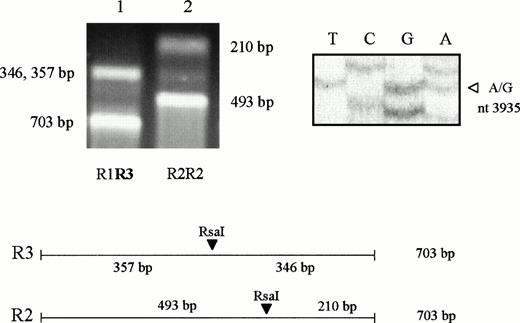To the Editor:
We have recently detected a genetic component in the factor V (FV) gene that contributes to activated protein C (APC) resistance both in the presence and in the absence of FV Leiden.1 It is a highly conserved FV gene haplotype with a wide geographical distribution, which encodes several aminoacid changes. This haplotype is marked by the R2 polymorphism,2 an A to G transition at position 4070 in exon 13 (B domain) that predicts the His1299Arg substitution, and is detectable by Rsa I restriction. The R2 haplotype was found to be conserved and similarly frequent (0.075) in four different populations (Somali, Southern Indians, Italians, and Greek Cypriots).
Genotyping of subjects of Somali origin at the 4070 polymorphic site revealed a new restriction pattern (Fig1), suggesting the presence of a different polymorphic Rsa I restriction site in the same amplicon. Direct sequencing (Fig 1) of the polymerase chain reaction (PCR) fragment in these subjects revealed an A to G transition at position 3935 (R3 polymorphism), which predicts the incorporation of an Arg in the place of His1254 (CAT/CGT).3 Six out of 40 Somali in our sample carried the new polymorphism in the heterozygous condition (frequency of the G allele 0.075). The 3935G allele could also be detected in Cypriots (1 out of 146 subjects was heterozygous, allele frequency 0.0034), whereas none of 40 Indians and 500 Italians was a carrier.
Detection and characterization of a new polymorphic marker in exon 13. Upper left, separation by electrophoresis of the PCR product digested with Rsa I. The gel (2% agarose) was run at 70 V for 1 hour. Lane 1, subject heterozygous for the R3 allele and for the frequent R1 allele. Lane 2, subject homozygous for the R2 allele. The restriction map for R2 and R3 alleles is reported below. Upper right, detection of the R3 polymorphism by sequencing. The A/G transition is indicated by the open arrow. Nucleotide numbering according to Jenny et al.3
Detection and characterization of a new polymorphic marker in exon 13. Upper left, separation by electrophoresis of the PCR product digested with Rsa I. The gel (2% agarose) was run at 70 V for 1 hour. Lane 1, subject heterozygous for the R3 allele and for the frequent R1 allele. Lane 2, subject homozygous for the R2 allele. The restriction map for R2 and R3 alleles is reported below. Upper right, detection of the R3 polymorphism by sequencing. The A/G transition is indicated by the open arrow. Nucleotide numbering according to Jenny et al.3
The R2 polymorphism is located in a highly repeated area of exon 13, characterized by 31 tandem repeats of the same 27-bp sequence, and affects the 20th nucleotide of the 16th repeat. We find it interesting that the new marker reproduces exactly the R2 polymorphism in the homologous position of the 11th repeat of exon 13, suggesting that the same molecular mechanism (5mC to T determination at a CpG dinucleotide) was probably responsible for both transitions. Both polymorphisms appear to be ancient, as indicated by their presence in the Somali population, which reflects the ancestral genetic state of mankind,4 but R3 shows a more limited geographical distribution. The finding of a new sequence variation in exon 13 of the FV gene confirms the extremely polymorphic nature of this exonic area, which seems to be subjected to loose sequence constraints.
Since the R2 marker is likely to be extensively investigated in various populations because of its involvement in APC resistance, we would like to point out that the new polymorphism can be easily distinguished from it by its restriction pattern (Fig 1).
ACKNOWLEDGMENT
The financial support of Telethon-Italy (Grant NE125) is gratefully acknowledged.


This feature is available to Subscribers Only
Sign In or Create an Account Close Modal